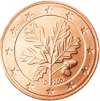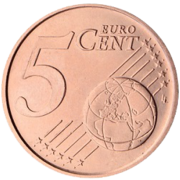| State
|
Details
|
Years of minting
|
Image
|
 Andorran euro coins Andorran euro coins
|
A Pyrenean chamois and a golden eagle.[3]
|
2014–onward
|
 Austrian euro coins Austrian euro coins
|
An Alpine primrose as a symbol of Austria's part in developing EU environmental policy. The words "FÜNF EURO CENT" (five euro cent) appear at the top with a hatched Austrian flag below with the date.
|
2002–onward
|

|
 Belgian euro coins Belgian euro coins
|
FIRST SERIES: An effigy of King Albert II. To the right-hand side among the stars was the king's monogram, a letter "A", underneath a crown. The year is lower down, also among the stars.[4]
|
1999–2007
|

|
| SECOND SERIES: A redesign to include the letters BE (standing for Belgium) beneath the monogram, which was moved out of the stars into the centre circle but still to the right of the king's renewed portrait. The date was also moved out and placed beneath the effigy and included two symbols either side (left: signature mark of the master of the mint, right: mint mark).[4]
|
2008–2013
|
|
| THIRD SERIES: In 2013, Albert II abdicated with Philippe of Belgium becoming king. He subsequently replaced Albert on Belgian coins.[4]
|
2014–onward
|
 Croatian euro coins Croatian euro coins
|
A ligature for Glagolitic letters ⰘⰓ (HR) and the word "Hrvatska" ("Croatia"), accomplished by a checkerboard in the background, designed by Maja Škripelj.
|
2023–onward
|

|
 Cypriot euro coins Cypriot euro coins
|
Two Mouflons, a species of wild sheep on Cyprus that represents the island's wildlife. It includes, in a semi-circle to the top right, the name of Cyprus in Greek and Turkish (ΚΥΠΡΟΣ and KIBRIS) each side of the date.
|
2008–onward
|

|
 Estonian euro coins Estonian euro coins
|
A geographical image of Estonia and the word "Eesti" ("Estonia").[5]
|
2011–onward
|
 Finnish euro coins Finnish euro coins
|
FIRST SERIES: The heraldic lion of Finland found on the Coat of arms of Finland. It is a reproduction of a design by the sculptor Heikki Häiväoja and has been used by previous Finnish coins such as the 1-markka between 1964 and 2001. The first series included the initial of the mint master of the Mint of Finland, Raimo Makkonen (an M), on the bottom left side of the lion and the date to the left.
|
1999–2007
|
| SECOND SERIES: When the coins were redesign to meet the new design requirements, the initial was replaced by the mint's mint mark and moved to the left, with the letters FI (for Finland) sitting in the bottom right.
|
2007–onward
|
 French euro coins French euro coins
|
Marianne, the feminine representation of France, its state and its values. It is the most prominent representation of France and its ideals of liberty and reason, dating from 1848. The depiction is young and determined, embodying France's desire for a sound and lasting Europe. The letters RF (République française), stylised, appear to the right above the year.[6]
|
1999–onward
|
 German euro coins German euro coins
|
An oak twig, an image carried over from the previous pfennig. The year and mint mark are shown at the bottom.
|
1999–onward
|

|
 Greek euro coins Greek euro coins
|
A modern cargo tanker symbolising modern Greek enterprise. Above it is the denomination in Greek and the year.
|
2001–onward
|
 Irish euro coins Irish euro coins
|
The national emblem of Ireland, an Irish harp (the Cláirseach, see Clàrsach). Vertically on the left-hand side is the word "Éire" (Ireland in the Irish language) and on the right hand side is the date. The harp motif was designed by Jarlath Hayes.
|
2002–onward
|
 Italian euro coins Italian euro coins
|
A depiction of the Flavian Amphitheatre (the Colosseum), built in the first century by Emperors Vespasian and Titus. The elliptical amphitheatre in the heart of Rome is Italy's most famous landmark and is one of the greatest works of architecture and engineering of the Roman Empire and the world. It includes the interconnected letters IR (Repubblica Italiana) to the top right and the year at the bottom.
|
2002–onward
|
 Latvian euro coins Latvian euro coins
|
A small coat of arms of the Republic of Latvia above the word LATVIJA (Latvia).
|
2014–onward
|

|
 Lithuanian euro coins Lithuanian euro coins
|
The Vytis (symbol of the coat-of-arms) and the word "Lietuva", which means "Lithuania". The twelve stars, symbols of the EU, surrounds the Vytis.
|
2015–onward
|

|
 Luxembourgish euro coins Luxembourgish euro coins
|
A stylised effigy of Grand Duke Henri of Luxembourg designed by Yvette Gastauer-Claire in consultation with the government and monarchy of Luxembourg. The name Lëtzebuerg (Luxembourg in Luxembourgish) and the year is written round the bottom of the coin.
|
1999–onward
|
 Maltese euro coins Maltese euro coins
|
Depicts an altar of the prehistoric megalith Mnajdra temples. The temples were built in the fourth millennium BCE on the southern coast overlooking the sea. Beneath the depiction is the name Malta and the year.
|
2008–onward
|
 Monégasque euro coins Monégasque euro coins
|
FIRST SERIES: The coat of arms of Monaco with the name MONACO across the top of the coin's outer circle and the year across the bottom of the outer circle with the mint marks.
|
2004–2006
|
|
| SECOND SERIES: When Prince Albert II succeeded Prince Rainier III in 2005, the overall design was kept but the name and the year were moved within the circle to bring it in line with the new designs of the other coins that had changed significantly.
|
2006–onward
|
 Dutch euro coins Dutch euro coins
|
FIRST SERIES: A stylised profile of Queen Beatrix of the Netherlands surrounded by the twelve stars and other dots, with the inscription "Beatrix Queen of The Netherlands" in Dutch around the edge. The date and mint marks are located at the bottom.
|
1999–2013
|
|
| SECOND SERIES: Following the accession to the throne of King Willem-Alexander, a new series of euro coins was issued depicting the effigy of the new Head of State.
|
2014–onward
|
|
 Portuguese euro coins Portuguese euro coins
|
The royal seal of 1134 (stylised "Portugal") surrounded by the country's castles and five escutcheons with silver bezants set in relation to the surrounding European stars, and is intended to symbolise dialogue, exchange of values and dynamics in the building of Europe. Between the castles are the numbers of the year towards the bottom and the letters of the name Portugal between the upper icons. The stars are inset on a ridge.
|
1999–onward
|
 Sammarinese euro coins Sammarinese euro coins
|
FIRST SERIES: The first of the Three Towers of San Marino: Guaita. In a semicircle above the tower to the right are the words San Marino and to the left, the date. The mint marks are shown to the lower right.
|
2002–2017
|
| SECOND SERIES: The official coat of arms of the Republic of San Marino, the City Gate and the Church of St Quirinus, respectively.
|
2018–onward
|
 Slovak euro coins Slovak euro coins
|
Kriváň, a notable peak of the Tatra mountains. Kriváň symbolises Slovakia's sovereignty. Below is the name SLOVENSKO (Slovakia), then the year and the coat of arms of Slovakia with the mint marks either side.
|
2009–onward
|
 Slovenian euro coins Slovenian euro coins
|
An interpretation of Ivan Grohar's painting of a sower. Grohar (1867–1911) was an Impressionist painter and is considered one of the leading figures of Slovene impressionism. The sower is a frequent motif in paintings and Grohar's image is embellished with round seeds and stars that, when scattered, float above the earth in elliptical patterns giving the impression of planets, drawing the sower close to the creator. The scattered stars join up with the twelve stars around the design (as in all the coins) and the number together reaches twenty-seven, the number of EU states that there were when Slovenia adopted the euro. Between each star round the right hand edge are the letters SLOVENIJA (Slovenia) with the date after it to the lower left.
|
2007–onward
|
 Spanish euro coins Spanish euro coins
|
FIRST SERIES: The Obradoiro façade of the Cathedral of Santiago de Compostela, a prime example of Spanish Baroque architecture started in 1667 by Jose del Toro and Domingo de Andrade and completed in the 18th century by Fernando Casas y Novoa. The cathedral, which is Romanesque and dates from 1128, is a major pilgrimage destination. The name España (Spain) is shown to the top left and the top left five stars are indented on a raised area, inverting the effect of the rest of the coin. The date is shown to the top right.
|
1999–2009
|
| SECOND SERIES: In 2010 the raised area around the stars was removed.
|
2010–onward
|
 Vatican euro coins Vatican euro coins
|
FIRST SERIES: An effigy of Pope John Paul II. The name CITTA DEL VATICANO (Vatican City), followed by the year and mint mark, was written in a break between the stars below.
|
2000–2005
|
| SECOND SERIES: Following the death of John Paul II in 2005, a new coin was issued during the Sede vacante until a new Pope was chosen. This contained the insignia of the Apostolic Chamber and the coat of arms of the Cardinal Chamberlain.
|
2005–2006
|
| THIRD SERIES: When Pope Benedict XVI was elected, his effigy appeared on the coins, with the name of the city now broken to his top right with the year and mint mark in the middle to his right.
|
2006–2013
|
| FOURTH SERIES: In 2014 the coins were updated with the election of Pope Francis. CITTA DEL VATICANO is written around the top, broken by Pope Francis's head, with the date below the O in Vaticano.
|
2014–2016
|
| FIFTH SERIES: After the announcement that Pope Francis would not appear on any coins issued by the Vatican, a new series of euro coins were issued to depict the papal coat of arms of Francis.
|
2017–onward
|








